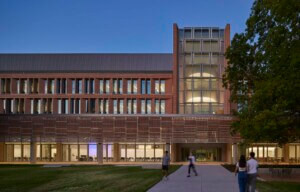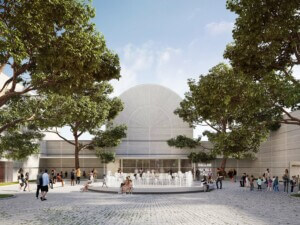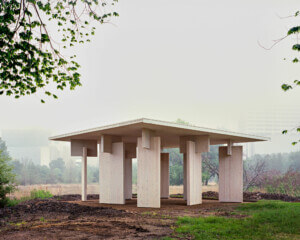A new building now under construction, the Moody Center for the Arts, designed by Los Angeles architect Michael Maltzan, continues the exploration of how to design new buildings for Rice University that respect and consider rather than imitate the existing buildings.
According to Maltzan, the parti for the Moody Center—which will house workshops, galleries, and performance spaces for an interdisciplinary arts center—is a “hyper village of making; a microcosm of the campus itself.”
Rice University’s campus in Houston is one of the most compelling in the United States. Its original master plan was devised by Boston architect Ralph Adams Cram in 1909 and is characterized by a series of parallel, narrow buildings. It has, at least in spirit, been a consistent guiding force for more than 100 years. Not only did Cram devise a building typology, but he also created a formal language for the entire campus based on a particular set of materials, like Lovett Hall (1912) with its orange St. Joe Brick made in Louisiana from bayou clay, pink Texas granite, and gray Ozark marble and exotic inspiration, Adriatic Italian Byzantine architecture of the medieval era.
Maltzan says he was struck by the physical sensations of being on the campus. A massive grove of live oaks—planted at the time of the college’s foundation—forms allées between the buildings and is green year round. It hovers over the flat campus, and defines space architecturally as much as the buildings.
In his scheme, Maltzan figuratively pushed together the long, bar-like buildings and the landscaped spaces between them to “exaggerate the intensity of spaces.” The irregular mass of smaller classrooms and workshops interspersed with larger galleries and theaters will be clad in a charcoal gray brick colored with shimmery magnesium oxide that changes in appearance from light to dark, much as the tree canopy does throughout the day. These brick walls, which are mostly solid except for large, strategically placed openings for day lighting, will be raised one story above the ground. The ground level will be entirely sheathed with clear glass, an echo of the clear sightlines through the tree trunks under the leafy canopy.
Although its radical appearance will be a big departure from the more conservative buildings near it, the Moody Center will hopefully become a valued landmark as the campus architecture of Rice University continues to evolve and adapt.
In recent years, there has been a subtle but palpable change apparent in the construction of key buildings like the Brochstein Pavilion (2009), designed by New York architecture firm Thomas Phifer + Partners, and the Brockman Hall for Physics (2011), designed by Philadelphia architects Kieran Timberlake. Both are fitted between existing buildings and use different strategies: one a glass box and the other raised on tapered pilotis to minimize the intrusion. With these
two buildings, a new, a less literal interpretation of Cram’s master plan has emerged that enhances and expands the original intent.










